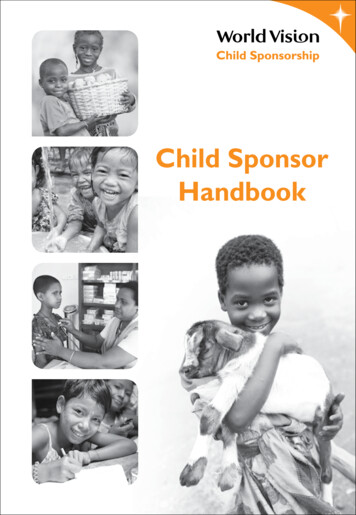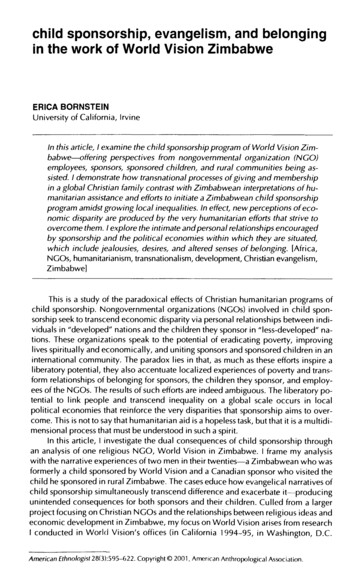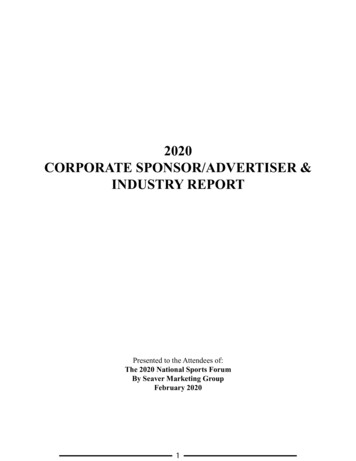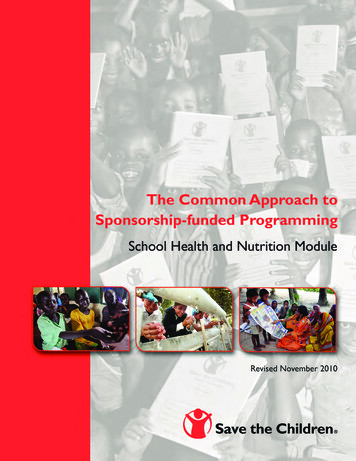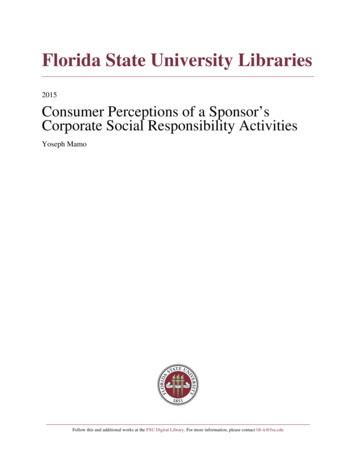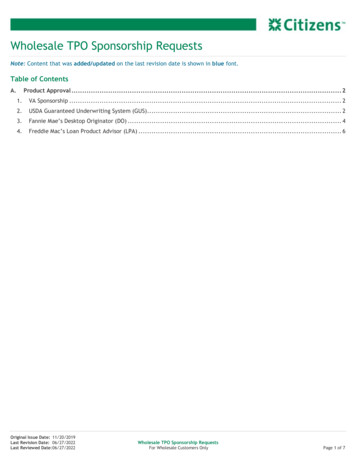
Transcription
MSc Global DevelopmentMaster’s ThesisName: Ben RobinsonStudent Number: ngz338Thesis Format: Internship Based ThesisSupervisor: Sam JonesTitle: Evaluating the Impact of Link Ethiopia’s ChildSponsorship Programme: A Mixed Methods ApproachSubtitle: To what extent are child sponsorship programmes anEffective way to Improve Educational Outcomes?Submission Date: 1st August 2016Total Keystrokes (Including Spaces): 165,102Total Standard Pages: 68.8ECTS: 30
AcknowledgementsI would like to thank all of the staff, from both Link Ethiopia and Kindu, inthe UK and in Ethiopia for their support in facilitating this research.Without their thoughtful cooperation, from the access of theirsponsorship databases to their support with the data collection processin schools, to prompt responses to requests for information, thisresearch would not have been possible. I would also like to thank mysupervisor, Sam Jones, for his guidance in both framing the study andsupport to help overcome challenges posed by the data.
Table of Contents1.Summary . 12.Literature Review . 52.1. Child Sponsorship around the World . 52.2. Measuring Impact in Education in the Global South . 83.Programme Context . 133.1. Education in Ethiopia . 133.2. Child Sponsorship Programmes in Gondar, Ethiopia . 154.Fieldwork Methodology and Observations . 224.1.4.2.4.3.4.4.5.Fieldwork Summary . 22Sampling . 22School Visits . 26Semi-Structured Interviews . 30Empirical Strategy . 325.1. Research Questions . 325.2. Outcome Variables . 325.3. Difference-in-Difference Analysis . 356.Results and Interpretation . 436.1. Are Child Sponsorship Programmes an Effective way to Improve EducationalOutcomes? . 436.2. Do Conditional Cash Transfers, in Addition to the Provision of SchoolResources, Improve Educational Outcomes? . 537.Discussion . 677.1.7.2.7.3.7.4.8.Relative Effectiveness of the Link Ethiopia Programme . 67Mechanisms of Sponsorship . 71Generalisability of Findings . 73Usefulness of Student-Level Data . 74Consultancy Report . 768.1.8.2.8.3.8.4.8.5.Summary of Main findings from the Quantitative Analysis . 76Programme Recommendations . 80Improving Monitoring and Evaluation of the Programme . 89Improving Link Ethiopia Monitoring and Evaluation . 92Conclusions for Link Ethiopia . 93Bibliography. IAppendix A: Interview Guide – Sponsored Students . IVAppendix B: Interview Guide – Link Coordinator. VAppendix C: Interview Ethics . VIAppendix D: Example Regression with Student Fixed Effects . VII
1. SummaryChild sponsorship programmes represent one of the most visible schemes in theNGO international development landscape to channel small private donations to theGlobal South. Despite the billions of dollars that pass through these channels, theexisting literature analysing the impact of such schemes is surprisingly limited. At therequest of Link Ethiopia, a UK-based NGO that operates solely in Ethiopia, thispaper analyses the impact of their two parallel child sponsorship programmes, theLink Ethiopia sponsorship scheme and The Kindu Trust (Kindu) sponsorshipscheme.Both schemes support students on the condition that the student is in some form ofeducational programme. The Link Ethiopia scheme provides school resources anduniforms, access to sponsorship clubs and access to an emergency health andcontingency fund to sponsored students, as well as raising money for an‘Educational Environment Improvement Fund’ allocated to the school where thestudent attends. The Kindu Trust scheme provides school resources and access to a‘training fund’ to sponsored students. The Kindu scheme also supports the family ofthe sponsored student, with a cash transfer, reimbursement of medical expenses,medical check-ups, and access to other Kindu programmes.Both schemes are assessed for their ability to improve the educational outcomes ofthe sponsored students that are supported through the scheme, although this paperplaces more emphasis on the Link Ethiopia sponsorship scheme. Given that childsponsorship schemes can vary greatly in nature, in many ways this paper is bestplaced within the strand of literature that seeks to measure and understand theeffectiveness of programmes that seek to improve educational outcomes in theGlobal South.1
Two main research questions are addressed in this paper:‘Are Child Sponsorship Programmes an Effective way to Improve EducationalOutcomes?’‘Do Conditional Cash Transfers, in Addition to the Provision of SchoolResources, Improve Educational Outcomes?’This paper uses a mixed-methods approach, as it not only measures the impact ofthe programmes, but also seeks to understand the mechanisms that underlie thesponsorship schemes. It provides recommendations as to how Link Ethiopia canimprove the programme, and its monitoring and evaluation processes across theorganisation. The research is based on a two-month field research placement at theLink Ethiopia regional office, in the town of Gondar, located in the Amhara region ofEthiopia.The quantitative analysis uses difference-in-difference analysis on individual-levelannual academic data to estimate the programme effects of the two sponsorshipprogrammes, by comparing three groups of students. These are: 98 studentssponsored by Link Ethiopia; 71 students sponsored by The Kindu Trust; and 184non-sponsored students. The time period for valid observations for this study wasfrom the 2005/6 academic year (1998 Ethiopian Calendar), to the 2014/15 academicyear (2007 Ethiopian Calendar).This analysis finds evidence of improved educational outcomes as the duration ofsponsorship increases, and this represents a result that is generalisable to manysponsorship schemes that directly support individuals with education. There is littleevidence that the programmes improve attainment at school, however there wasstrong evidence of a relationship between access to, and progress through theeducation system, and sponsorship duration.Curiously, there is convincing evidence that there is a non-linear relationshipbetween the duration of Link Ethiopia sponsorship and enrolment and promotionrates, where for the first years of sponsorship these rates decline, but thereafterimprove exponentially. There are a number of reasons for this relationship, many of2
them idiosyncratic to the Link Ethiopia programme, however they serve to highlightthe importance of an effective student selection process in maximising the impact ofa sponsorship programme.This study estimates that at the end of the 2014/15 academic year, the Link Ethiopiasponsorship programme had resulted in an additional 0.31 years of schooling perstudent, at a cost of 391.53 per additional year of schooling. The efficiency of thisprogramme and positive impact on educational outcomes seem set to improve in thefollowing years. There was no quantitative evidence that conditional cash transfers(CCTs), when present in addition to the provision of school resources improveeducational outcomes for students. However, there was qualitative evidence tosuggest that CCTs incentivised education.The qualitative analysis is based on ethnographic observations from the fieldwork,which involved working with the Link Ethiopia and Kindu country staff, visitingschools where sponsored students attend in order to collect the academic data, andthrough semi-structured interviews with nine sponsored students and one ‘LinkCoordinator’. The collaboration with staff and schools helped to inform thehypotheses, enhance the reliability, and improve the interpretation, of thequantitative data; and helped to develop potential improvements in monitoring andevaluation for both the sponsorship programmes and across Link Ethiopia’s work.The semi-structured interviews found that sponsorship is an effective model toimprove educational outcomes, through reducing the private costs to education,providing school uniforms and school resources, and by offering emotional supportto raise student’s educational aspirations. The interviews also helped to informrecommendations for improving the sponsorship programmes.The remainder of the paper is organised as follows. Section 2 provides a literaturereview of both child sponsorship literature and measuring impact in education in theGlobal South. Section 3 provides the context of the education system in Ethiopia,and background information on Link Ethiopia, The Kindu Trust and the sponsorshipprogrammes. Section 4 describes the fieldwork methodology and observations.Section 5 outlines the empirical strategy employed on the quantitative data. Section3
6 presents the results from the quantitative data and interprets these findings.Section 7 places the quantitative findings back into the broader context of theeffectiveness of educational programmes in the Global South, and uses the semistructured interviews to explore the mechanisms that allow sponsorship programmesto be effective. Section 8 is a consultancy report, primarily targeted at Link Ethiopia,which summarises the main findings, and presents possible recommendations toimprove both the sponsorship programmes, the monitoring and evaluation of theprogramme and potential future research to be carried out on the programme, beforeoffering ways in which Link Ethiopia can improve its monitoring and evaluationacross its Ethiopian programmes.4
2. Literature Review2.1. Child Sponsorship around the World1Child sponsorship is a model of north-south private financial flows, one that variesfrom NGO to NGO; however programmes typically include regular giving, a desire fordonations to primarily benefit individuals and the provision of regular updates tosponsors (Watson & Clarke 2014). Child sponsorship may be to some organisationslittle more than an effective fundraising mechanism where donations are ‘given in thename of a sponsored child to create village-level public goods’ (Wydick et al. 2013:397), whereas in others, child sponsorship is ‘programmatically defining as anindividualised model of development’ (Robinson 2016: 9).Organisations such as Plan International and Save the Children favour the formermodel, whereas at Compassion International ‘sponsors pay for children’s schooltuition and uniforms, several nutritious meals per week, health care, and tutoring’(Wydick et al. 2013: 395). This individualised model of development is perhaps themost recognisable model of child sponsorship, particularly in the eyes of the donor,and for Rabbitts (2012) child sponsorship ‘usually takes the form of long-termcommitments to monthly remittances that cover the medical and educationalrequirements of individual children in the Global South’.Proto-models of child sponsorship were arguably pioneered by Save the Children UKand the Society of Friends in Austria as early as 1920, providing rations to children(Watson 2014b). Organisations built on the initial successes of these programmes.Schemes that ‘involved direct handouts, service provision and cash transfers tochildren and their families for food, medicine and school needs’ (Watson 2014a)grew particularly in the 1960s and 1970s. In the 1980s criticism of child sponsorshipprogrammes in an international development context grew, and these argumentswere crystallised in the famous ‘Please do not sponsor this child’ (Stalker 1982)article. The article criticised sponsorship programmes for high operational costs,favouring certain individuals over others in deprived communities rather than1This section draws heavily on the background material found in Robinson (2016) – See Section 4.1Child Sponsorship Models5
supporting community development, and for cultivating empty aspirations that wouldnever be realised for beneficiaries.This shift in attitudes prompted the emergence of the village-level public goodsmodel of child sponsorship as a fundraising mechanism for community developmentprogrammes, as these were considered to be schemes with greater potential forsustainable poverty reduction than individualised giving (Watson et al. 2014).However, in recent times, there has been a re-evaluation of whether such criticism iscompletely warranted. Whilst sponsorship is still not considered a solution forsustainable or systemic poverty reduction, ‘if designed wisely, targeted carefully, andimplemented efficiently, sponsorship programmes usefully add to the livelihoods ofdisadvantaged families in environments that lack alternative safety nets’ (vanEekelen 2013: 474).Whilst the variety of child sponsorship programmes makes it difficult to define whatis, and what is not a sponsorship scheme, when including both the public goods andindividual support models, an estimated 3.29bn (Wydick et al. 2013) is thought toflow through child sponsorship schemes annually. Given the large volume ofmonetary flows through child sponsorship programmes, the amount of literaturemeasuring the impact of these programmes is surprisingly limited. Until 2013, theonly example of a widely available impact evaluation was a randomised control trial(RCT) analysed by Kremer et al. (2003), which measured the impact of the provisionof classroom construction, school uniforms and textbooks through a sponsorshipmodel conducted by a Dutch NGO, International Christelijk Steunfonds (ICS). Such aprogramme could be considered to be both a combination of the public-goods model(classrooms) and individual support (uniform and textbooks). This paper found thatthese interventions had a positive impact on attendance at school, and reduceddropout rates, resulting in a 17% increase in years of schooling, and improved gradeattainment (grade progressed in the time period), by 15%.As programmes, models of individual support, and public goods models are verydifferent, and therefore measuring the impact of the two different models wouldrequire two very different approaches. Wydick et al. (2013: 397) suggest that the6
potential impacts of programmes that use the village-level public goods models are‘more diffuse and more difficult to assess’. In light of this issue, when carrying out animpact assessment of Plan International’s sponsorship scheme, Pettit & Shutt(2008:13) opt for a ‘comparative analysis of Plan’s own intentions, practices andoutcomes, rather than [ ] a test against a specific set of standards or indicators’.In the aforementioned paper, Kremer et al. (2003) are able to overcome thischallenge for a number of reasons. Firstly, the analysis was carried out as aprospective RCT, with treatment and control schools, meaning that the study did nothave to be concerned with other factors influencing school performance due to thetreatment schools being randomly selected. In the case of the Plan Internationalanalysis, any assessment would have been both retrospective, and the distribution ofpublic goods non-random, meaning any analysis would be subject to omittedvariable bias. Secondly, the ICS sponsorship scheme was designed such that thevast majority of students received free uniforms, and the textbooks were distributedto the schools to be used by students. This meant that the effect of the programme,could be measured at a school-level, with the entire package of uniforms, textbooksand classroom construction treated as a school-level public good, rather thanmeasuring the impact of individual support for a child, at an individual level.This lack of research estimating the impact of individualised models of childsponsored changed with Wydick et al.'s (2013) paper, ‘Does International ChildSponsorship Work? A Six-Country Study of Impacts on Adult Life Outcomes’. Thisrepresented a comprehensive evaluation of a large-scale child sponsorshipprogramme, analysing data ‘on the life outcomes of 10,144 individuals from sixdeveloping countries that are representative of the Compassion program’s workworldwide: Bolivia, Guatemala, India, Kenya, the Philippines, and Uganda’ (Wydicket al. 2013: 394).Wydick et al.'s (2013) paper examines the impact of the programme on theeducational, employment and community leadership outcomes of sponsoredstudents. In terms of educational outcomes, the outcome variables of interest toWydick are total years of formal education, and the percentage of students7
completing primary, secondary, and university education. The study uses both OLSand IV regressions, with fixed-effects at a household level, and estimates forspillover effects, both within, and between households, to estimate the impact of theCompassion sponsorship programme on these outcome variables. The paperultimately finds that the Compassion sponsorship programme has positive impactson all of these outcomes, and suggests that the focus of the Compassionprogramme on building the self-esteem and aspirations of the students is the drivingfactor of these positive outcomes. Glewwe et al. (2013) confirm this causalrelationship between the Compassion sponsorship programme and improved selfesteem, and higher expectations for educational and employment outcomes.This, and the Kremer et al. (2003) paper remain the only two, widely availablequantitative studies that measure the impact of child sponsorship. However, asWydick et al. (2013: 395) indicates, ‘Compassion [sponsorship] projects are similarto many government and international donor programmes that promote education.Sponsors pay for children’s school tuition and uniforms, several nutritious meals perweek, health care, and tutoring.’ Keeping this in mind, studies that explore effectiveways to improve educational outcomes in the Global South represent a broaderstrand of literature that child sponsorship impact evaluations can be considered to bepart of.2.2. Measuring Impact in Education in the Global South2Despite criticism from esteemed economists such as Deaton (2010), RCTs are oftenseen as the ‘gold standard’ when measuring the effectiveness of developmentprogrammes. Glewwe et al. (2004) illustrate the advantages of prospective overretrospective analysis by carrying out different analytical approaches to measure theimpact of introducing flipcharts to schools in Kenya. They demonstrate how that evenwhen controlling for observable school inputs, results from OLS regressions cansuggest that the introduction of flipcharts increases test scores by 20% of a standard2This section draws on the background material found in Robinson (2016) – See Section 5.1 How dowe measure impact in education?8
deviation. However, when the same experiment is carried out as an RCT, there is noevidence that flipcharts have a statistically significant impact on test scores.They attribute this difference to a failure of the retrospective methodology toadequately account for omitted variable bias, and thus upwardly biasing theprogramme effects. This occurs if ‘it is more plausible that variation in the input ofinterest is influenced by variation in the unobserved inputs, or that unobserved inputsvary in response to the (observed) input of interest’ (Glewwe et al. 2004: 256). Whilstthis means that prospective analysis is generally preferable, clearly the possibility todo so does not always exist. The study also shows that when retrospective analysisis used, the results from a difference-in-difference analysis, whilst still overstating theimpact of flipcharts compared to the prospective analysis, are much closer to theprospective analysis than a mere OLS regression. Thus, if a difference-in-differenceapproach is used, and awareness of possible upward bias is maintained, this mayrepresent a best-case scenario when retrospective analysis is necessary.Irrespective of the method, understanding the results from different impactassessments of educational programmes provides important context, allowingdifferent programmes to be compared in their effectiveness. Common to suchstudies, is an understanding of education as a system that takes in a range of inputs,to produce educational outcomes, and then an attempt to measure the effect of achange in these inputs. Across the literature, this is done by a construction ofcounterfactual outcomes (outcomes in the absence of the programme), which allowsthe isolation and estimation of the change in educational outcomes due to a changein a given input or inputs.Given the preference in the literature for RCTs, many studies use this methodology.Often quoted examples of these studies include Evans et al. (2009), which showsthat the distribution of free school uniforms reduced absenteeism by 39% across allstudents, and by 66% when only considering the poorest students; and Kremer et al.(2009) who find that a merit-based scholarship in the form of school fees and grantsfor girls in Kenya improved attendance by 5% and possibly caused smallimprovements in test scores for both boys and girls. Alternatively, Glewwe et al.9
(2009) find that textbook provision has little effect on test scores, except for the bestperforming students. As well as educational inputs, health and nutrition inputs mayalso have an effect on educational outcomes, as Vermeersch & Kremer (2004) foundthat the provision of school meals can increase school participation by 30%.One form of programme that has received more extensive analysis is the impact ofconditional cash transfers (CCTs), where families receive cash in exchange for theattendance of their children at school, on educational outcomes. The best known,and most-evaluated of the schemes (due to it being designed as an RCT) is thePROGRESA programme in Mexico, now known as Oportunidades. The programmeresulted in higher enrolment rates, lower grade repetition, and lower dropout rates(Behrman et al. 2005), with further analysis estimating that receiving the cashtransfers for 5.5 years increased grades completed by 0.8–1.0 years (Behrman et al.2011).Despite the preference for RCTs there are also a range of studies that useretrospective analysis to assess the impact of different inputs on educationaloutcomes. One example is Filmer & Schady's (2008) analysis of an annual 45scholarship for girls in Cambodia, which increased both enrolment and attendanceby about 30 percentage points, with greater benefits for girls with lower socioeconomic indicators. In another study, Handa & Peterman (2007), find that childattainment in South Africa is partly a function of their nutritional status, Kingdon &Drèze (2001) demonstrate that the provision of midday meals, as means to reducingthe private costs of schooling, increases the chance of a girl completing primaryeducation by 30%, and improves their attendance by 15%.In recent years, the measurement of impact in development programmes has beeninfluenced by effective altruism. Effective altruism is best understood as a movementconstituted of academics, think-tanks, such as the Centre for Effective Altruism, andnon-profit organisations, such as GiveWell, that encourage individuals to donatemore of their income, but only to those causes that have the most effectiveoutcomes. MacAskill (2015) and Singer (2015) combine the moral philosophy ofutilitarianism with the growing evidence base of econometric analysis to make the10
case for increases in foreign aid, particularly through private channels. At the sametime, they argue that given that the financial resources for foreign aid are finite, thedistribution of aid should be directed towards those programmes that have thebiggest impact per dollar expended, meaning that cost-effectiveness is a morerelevant consideration than merely an aggregate measure of programme effects.In the field of education in the Global South, however, such evaluations are limited innumber, and ‘little reliable information is available regarding how to improve schoolattendance and school quality, or on the true relationship between schooling andlater-life outcomes such as income’ (GiveWell 2009). Some exceptions to this areMiguel & Kremer (2004), who calculate that a deworming programme can deliver anadditional year of schooling for 3.50; Evans et al. (2009), who calculate that auniform distribution programme costs 91 for each additional year of schooling, andEvans & Ghosh (2008), who calculate that the PROGRESA programme costs 614for each additional year. Whilst the first two studies both take place in a Kenyancontext, the PROGRESA programme of course operates in a Mexico, a middleincome country, which at least in part explains the higher costs to improvingeducational outcomes.Whilst a retrospective study is carried out on a limited set of already available data,as opposed to a prospective study where the data collection is planned prior to theintervention, the metrics used in assessing the impact of educational programmesare largely similar across the literature. Educational impact assessments often referto ‘increased years of schooling’. In the deworming study Miguel & Kremer (2004)estimate years of schooling gained through improved attendance, whereas Schultz(2004) calculates the increased years of schooling on the basis of increasedenrolment rates under the Mexican PROGRESA programme. The use of suchstandard metrics facilitates the easy comparison of the effectiveness of differentprogrammes.‘Increased years of schooling’, however, is not the only relevant metric whenmeasuring educational programmes. In the examples mentioned so far, attendancerates, enrolment rates and test scores have all been relevant outcomes to measure.11
As already mentioned, in Wydick et al.'s (2013) analysis of the Compassion childsponsorship scheme, the chosen metrics are the completed years of schooling, andcompletion rates of primary, secondary and university education.Many impact evaluations not only account for the impact of the programme on thetargeted beneficiaries, in this case the sponsored children, but also account for anyspillover effects. In identifying the impacts of a deworming programme in Kenya,Miguel & Kremer (2004) measure the impact of the treatment at a school level toaccount for externalities between students, and the impact on neighbouring schoolsfor inter-school spillovers. Likewise, Wydick et al. (2013) estimate the effects ofsponsorship on younger siblings.Circumstances though, require that in this paper historic data is used, and thatretrospective analysis is required. This paper therefore uses a difference-indifference approach similar to that used in Glewwe et al. (2004), an approach that iselaborated on in the ‘Empirical Strategy’.12
3. Programme Context3.1. Education in Ethiopia3The backdrop to education in Ethiopia is the prevalence of poverty, with 30% ofEthiopians living in extreme poverty (based on a national poverty line of 0.6 a day).This has however, fallen from 39% since 2005 due to strong recent economic growth(Ministry of Education 2015a). Despite spending 25.2% of government expenditureon education in 2013/14 (Ministry of Education 2015b), this still only amounted to39,857 million Ethiopia Birr (ETB) ( 1,811 million) (Ministry of Education 2015b),approximately only 20 per capita, a very low level by international standards. Figure1 illustrates this lack of finance for education in Ethiopia, and its dependence onforeign aid, as it is facing a financing gap of 70,131 million ETB over the next fiveyears.Figure 1: Estimated financing gap for each year of ESDP V (million birr)Source: (Ministry of Education 2015a)In spite of these challenges though, in working towards the Millennium DevelopmentGoals (MDGs) Ethiopia has seen significant progress in increasing its Net EnrolmentRate at primary sc
2.1. Child Sponsorship around the World1 Child sponsorship is a model of north-south private financial flows, one that varies from NGO to NGO; however programmes typically include regular giving, a desire for donations to primarily benefit individuals and the provision of regular updates to sponsors (Watson & Clarke 2014).


